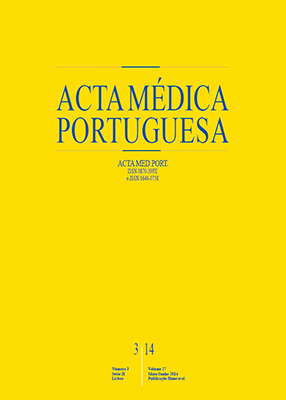The Geography of Diabetes Mellitus in Portugal: How Context Influence the Risk of Dying
DOI:
https://doi.org/10.20344/amp.4019Abstract
Introduction: Diabetes Mellitus is a public health problem that is on the increase throughout the world, including in Portugal. This paper aims to identify the changing geographic pattern of this cause of death in Portugal and its association with sociomaterial deprivation.Material and Methods: This is a transversal ecological study of the deaths by Diabetes Mellitus in Portuguese municipalities in three periods (1989-1993, 1999-2003 and 2006-2010). It uses a Bayesian hierarchical model in order to obtain a smooth standardized mortality ratio and the relative risk of death by Diabetes Mellitus associated to sociomaterial deprivation.
Results: In 1989-1993, the highest smooth standardized mortality ratio values were found in coastal urban municipalities (80% of municipalities with smooth standardized mortality ratio ≥ 161, of which 60% are urban); in 2006-2010, the opposite was found, with the highest smooth standardized mortality ratio values occurring in rural areas in southern inland regions (76.9% of municipalities with smooth standardized mortality ratio ≥ 161, of which 69.2% are rural), particularly the Alentejo. The relative risk of death by Diabetes Mellitus increases with vulnerability associated to social and economic conditions in the area of residence, and is significant in the last two periods (relative risk: 1.00; IC95%: 0.98-1.02).
Discussion: Diabetes Mellitus presents a geographic pattern marked by coastal-inland and urban-rural asymmetry. However, this has been altering over the last twenty years. 48% of the population reside in municipalities where the smooth standardized mortality ratio has increased in the last twenty years, particularly in the rural areas of inland Portugal.
Conclusion: The highest smooth standardized mortality ratio are currently found in rural municipalities with the highest index of sociomaterial deprivation.
Keywords: Demography; Diabetes Mellitus/epidemiology; Diabetes Mellitus/mortality; Portugal; Socioeconomic Factors.
Downloads
Downloads
Published
How to Cite
Issue
Section
License
All the articles published in the AMP are open access and comply with the requirements of funding agencies or academic institutions. The AMP is governed by the terms of the Creative Commons ‘Attribution – Non-Commercial Use - (CC-BY-NC)’ license, regarding the use by third parties.
It is the author’s responsibility to obtain approval for the reproduction of figures, tables, etc. from other publications.
Upon acceptance of an article for publication, the authors will be asked to complete the ICMJE “Copyright Liability and Copyright Sharing Statement “(http://www.actamedicaportuguesa.com/info/AMP-NormasPublicacao.pdf) and the “Declaration of Potential Conflicts of Interest” (http:// www.icmje.org/conflicts-of-interest). An e-mail will be sent to the corresponding author to acknowledge receipt of the manuscript.
After publication, the authors are authorised to make their articles available in repositories of their institutions of origin, as long as they always mention where they were published and according to the Creative Commons license.









